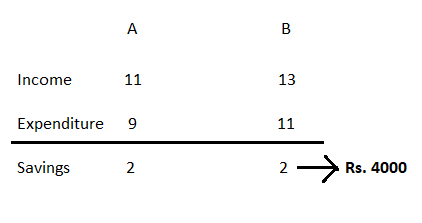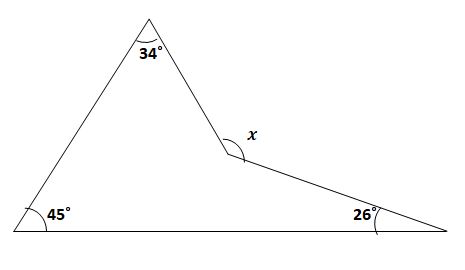Question
The ratio of the monthly incomes of A and B is 11: 13
and the ratio of their expenditures is 9: 11. If both of them manage to save ₹4,000 per month, then find the difference in their incomes (in ₹).Solution
Let, the monthly income of A = 11x The monthly income of B = 13x The monthly expenditures of A = 9y The monthly expenditures of B = 11y So, 11x - 9y = 4000 .....(1) 13x - 11y = 4000 .....(2) (1) × 11 - (2) × 9 gives, 121x - 99y - 117x + 99y = 44000 - 36000 ⇒ 4x = 8000 ⇒ x = 8000/4 = 2000 ∴ A's income = 11 × 2000 = Rs. 22000 ∴ B's income = 13 × 2000 = Rs. 26000 The difference of income = 26000 - 22000 = Rs. 4000 Alternate method  The difference = 2 ratio = Rs. 4000 Their income difference = 13 - 11 = 2 ratio ∴ Income difference = Rs. 4000 ∴ The difference between A and B's incomes (in Rs.) is Rs. 4000
The difference = 2 ratio = Rs. 4000 Their income difference = 13 - 11 = 2 ratio ∴ Income difference = Rs. 4000 ∴ The difference between A and B's incomes (in Rs.) is Rs. 4000
A △ ABC has sides 5 cm, 6 cm and 7 cm. AB extended touches a circle at P and AC extended touches the same circle at Q. Find the length (in cm) of AQ.
- A triangle has a base of 22 cm and the corresponding height is 9.5 cm. Calculate its area.
Determine the hypotenuse of an isosceles right-angled triangle where each of its equal sides measures 9√7 cm.
In △ ABC, D and E are the points on sides AB and AC. respectively and DE | BC. BC = 8 cm and DE = 5 cm. If the area of △ ADE = 45 cm², then wha...
In triangle △ ABC, the internal angle bisectors of ∠ B and ∠ C intersect at point OO. If the measure of ∠ BAC = 50o , determine the m...
If the ratio of areas of two similar triangles is 25:49, then the ratio of their corresponding sides is?
The angles of a triangle are in the ratio 4:5:3. Determine the sum of the smallest and largest angles of the triangle.
- The base of a right pyramid is an equilateral triangle with side 7 cm. If the height of the pyramid is 32√3 cm, then find the volume of the pyramid.
The area of an equilateral triangle is 432√3 cm2 . If a square is drawn using the height of the triangle as one of the sides, then find the...
In the Figure given below, find the value of x?

Relevant for Exams:


